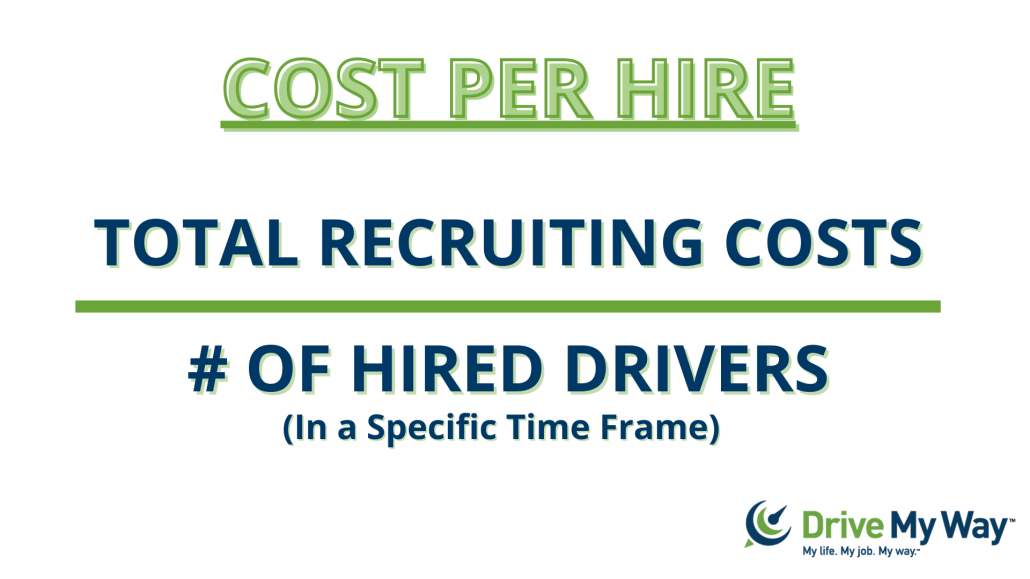
There are many metrics that a carrier can use to measure its hiring success. Some metrics are more well defined and simple like time to hire, while others are more subjective and harder to wrangle, like driver happiness.
But no matter what metrics you look at, the dollars spent to hire a candidate is traditionally thought of as the most important. That’s why carriers need to know what these costs are and how to measure them effectively. Let’s take a look at the true cost of hiring a truck driver.
How to Calculate Your Cost Per Hire
Before you can reduce your CPH, you need to know how to calculate it. Luckily, calculating CPH is pretty simple math.
You add up your total costs for recruiting new drivers, and then divide that by the number of drivers ultimately hired. This gives you the cost per hire for all your recruiting efforts. (Note that this factors in actual hires, not just leads.) You can use this formula to measure CPH over any time period you’d like, including month, quarter, or year.
So, What’s the Real Cost of Hiring a Truck Driver?
When nailing down the cost of hiring a driver, the actual math is not the tough part. It’s finding all the factors that go into the cost of hiring. This means all the costs, not just the ones associated with finding driver candidates, like job advertising and using recruiting services.
Your company’s cost per hire will be unique to the way you recruit and hire drivers. And it might take some time and refinement to ensure you’re calculating it correctly. Here’s a list of the most common costs associated with hiring a truck driver.
Turnover Is Your Enemy
Now that you understand the calculation for cost per hire, there’s another piece of the hiring puzzle that needs to be factored in as well; your turnover rate.
It’s widely known that the trucking industry faces very high turnover rates. According to some surveys, over 50% of newly hired drivers will leave their carriers within the first six months. In some cases, turnover can be closer to 90-100% over a year.
Looking at those stats, it’s easy to see that turnover is a huge problem for many carriers. To avoid high turnover, don’t fall into the trap of hiring drivers to fill an empty rig as quickly as possible.
If you’re hiring quickly and not taking the time to ensure you’re a good match for each other, it’s not likely it’s going to be a relationship that will last and will raise that hiring cost. If you keep repeating that cycle, it’s going to cost your company exponentially more and you’re still going to have empty seats to fill.
Every time you hire a new trucker, do it with the intention to retain that driver for a long time. The best way to do this is by really taking the time to get to know your candidates during the interview process so you can see if them coming onboard with your carrier is truly a fit for both sides. Doing this is the number one way to lower driver turnover, and in turn, lower the cost of hiring.
Measure Consistently for Best Results
Once you’ve found all your costs, the most important thing to do is to measure consistently. This is the only way that you’re going to be able to compare things year-over-year or month-over-month to see if the changes you’re making are truly helping to reduce your true cost of hiring a truck driver.
Don’t add in costs for one timeframe, then remove those costs the next time you calculate. If you do this, then you’re comparing apples and oranges and won’t have an accurate picture of your recruiting process.
Once you are tracking consistently, you should see some trends that help inform changes to your overall hiring strategies. Overall, you want this number to be as low as possible to deliver you a quality driver who wants to stay with your company.





 Comprehensive CDL Recruitment Solutions
Comprehensive CDL Recruitment Solutions

 Developing trust with drivers requires a significant investment of time. Building a relationship with drivers takes multiple touchpoints, ideally on their schedule. That may mean making time during evenings or weekends to speak with drivers. In conversations with prospective drivers, be clear early on about pay, hours, home time, and other key details. Your total number of driver leads may decrease as a result, but it’s worth it. As a result, you will
Developing trust with drivers requires a significant investment of time. Building a relationship with drivers takes multiple touchpoints, ideally on their schedule. That may mean making time during evenings or weekends to speak with drivers. In conversations with prospective drivers, be clear early on about pay, hours, home time, and other key details. Your total number of driver leads may decrease as a result, but it’s worth it. As a result, you will 



